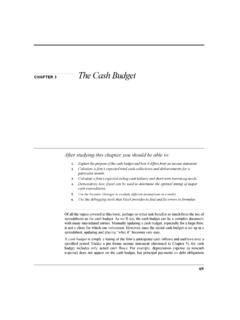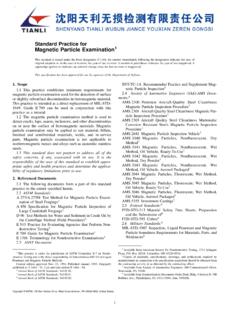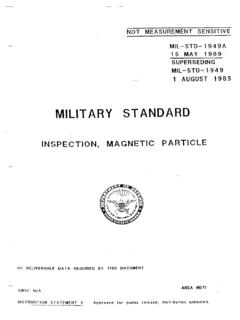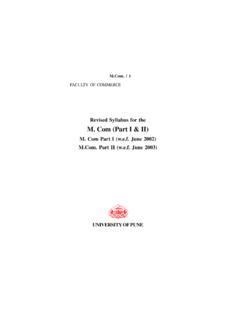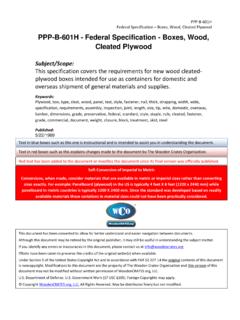Transcription of Printing - Standard Methods for the Examination …
1 Standard Methods for the Examination of water and wastewater Copyright 1999 by American Public Health Association, American water Works Association, water Environment Federation 5. KRASNER, , MCGUIRE & FERGUSON. 1985. Tastes and odors: the flavorprofile method. J. Amer. water Works Assoc. 77:34. 6. BARTELS, , BRADY & SUFFET. 1989. Appendix A in Taste and Odor inDrinking water Supplies Phases I and II. American water Works Assoc. ResearchFoundation, Denver, Colo. 7. MALLEVIALLE, J. & SUFFET, eds. 1981. Identification and Treatment of Tastes andOdors in Drinking water . Appendix A. American water Works Assoc.
2 , Denver, Colo. 8. BARTELS, , BRADY & SUFFET. 1987. Training panelists for the flavorprofile analysis method. J. Amer. water Works Assoc. 79:26. 9. SUFFET, , J. HO, D. CHIOU, D. KHIARI & J. MALLEVIALLE. 1995. Taste-and-odorproblems observed during drinking water treatment. In Suffet, J. Mallevialle & , eds. Advances in Taste and Odor Treatment and Control. AmericanWater Works Assoc. Research Foundation & Lyonnaise des Eaux, Denver, Colo. 10. CAUL, 1957. The profile method of flavor analysis. In Advances in Food Research,Vol. 7. Academic Press, New York, 11. BURLINGAME, , D. KHIARI & SUFFET. 1991.
3 Odor reference standards : Theuniversal language. Proc. AWWA water Quality Technology Conf., Miami, Fla., p. 7. 12. MENG, A. & SUFFET. 1992. Assessing the quality of flavor profile analysis data. water Works Assoc. 84:89. 13. KRASNER, 1995. The use of reference materials in sensory analysis. water 31(11) Bibliography AMERICAN water WORKS ASSOCIATION. 1993. Flavor Profile Analysis: Screening andTraining of Panelists. AWWA Manual. American water Works Assoc., Denver, ACIDITY*#(28)2310 A. Introduction Acidity of a water is its quantitative capacity to react with a strong base to a designated measured value may vary significantly with the end-point pH used in the is a measure of an aggregate property of water and can be interpreted in terms of specificsubstances only when the chemcical composition of the sample is known.
4 Strong mineral acids,weak acids such as carbonic and acetic, and hydrolyzing salts such as iron or aluminum sulfatesmay contribute to the measured acidity according to the method of determination. Acids contribute to corrosiveness and influence chemical reaction rates, chemical speciation,and biological processes. The measurement also reflects a change in the quality of the sourceStandard Methods for the Examination of water and wastewater Copyright 1999 by American Public Health Association, American water Works Association, water Environment Federationwater. 2310 B. Titration Method1. General Discussiona. Principle: Hydrogen ions present in a sample as a result of dissociation or hydrolysis ofsolutes react with additions of Standard alkali.
5 Acidity thus depends on the end-point pH orindicator used. The construction of a titration curve by recording sample pH after successivesmall measured additions of titrant permits identification of inflection points and bufferingcapacity, if any, and allows the acidity to be determined with respect to any pH of interest. In the titration of a single acidic species, as in the standardization of reagents, the mostaccurate end point is obtained from the inflection point of a titration curve. The inflection pointis the pH at which curvature changes from convex to concave or vice versa. Because accurate identification of inflection points may be difficult or impossible in bufferedor complex mixtures, the titration in such cases is carried to an arbitrary end-point pH based onpractical considerations.
6 For routine control titrations or rapid preliminary estimates of acidity,the color change of an indicator may be used for the end point. Samples of industrial wastes, acidmine drainage, or other solutions that contain appreciable amounts of hydrolyzable metal ionssuch as iron, aluminum, or manganese are treated with hydrogen peroxide to ensure oxidation ofany reduced forms of polyvalent cations, and boiled to hasten hydrolysis. Acidity results may behighly variable if this procedure is not followed exactly. b. End points: Ideally the end point of the acidity titration should correspond to thestoichiometric equivalence point for neutralization of acids present.
7 The pH at the equivalencepoint will depend on the sample, the choice among multiple inflection points, and the intendeduse of the data. Dissolved carbon dioxide (CO2) usually is the major acidic component of unpolluted surfacewaters; handle samples from such sources carefully to minimize the loss of dissolved gases. In asample containing only carbon dioxide-bicarbonates-carbonates, titration to pH at 25 Ccorresponds to stoichiometric neutralization of carbonic acid to bicarbonate. Because the colorchange of phenolphthalein indicator is close to pH , this value generally is accepted as astandard end point for titration of total acidity, including CO2 and most weak acids.
8 Metacresolpurple also has an end point at pH and gives a sharper color change. For more complex mixtures or buffered solutions selection of an inflection point may besubjective. Consequently, use fixed end points of pH and pH for Standard aciditydeterminations via a potentiometric titration in wastewaters and natural waters where the simplecarbonate equilibria discussed above cannot be assumed. Bromphenol blue has a sharp colorchange at its end point of The resulting titrations are identified, traditionally, as methylorange acidity (pH ) and phenolphthalein or total acidity (pH ) regardless of theactual method of measurement. Standard Methods for the Examination of water and wastewater Copyright 1999 by American Public Health Association, American water Works Association, water Environment Federationc.
9 Interferences: Dissolved gases contributing to acidity or alkalinity, such as CO2, hydrogensulfide, or ammonia, may be lost or gained during sampling, storage, or titration. Minimize sucheffects by titrating to the end point promptly after opening sample container, avoiding vigorousshaking or mixing, protecting sample from the atmosphere during titration, and letting samplebecome no warmer than it was at collection. In the potentiometric titration, oily matter, suspended solids, precipitates, or other wastematter may coat the glass electrode and cause a sluggish response. Difficulty from this source islikely to be revealed in an erratic titration curve.
10 Do not remove interferences from samplebecause they may contribute to its acidity. Briefly pause between titrant additions to let electrodecome to equilibrium or clean the electrodes occasionally. In samples containing oxidizable or hydrolyzable ions such as ferrous or ferric iron,aluminum, and manganese, the reaction rates at room temperature may be slow enough to causedrifting end points. Do not use indicator titrations with colored or turbid samples that may obscure the colorchange at the end point. Residual free available chlorine in the sample may bleach the this source of interference by adding 1 drop of sodium thiosulfate (Na2S2O3). d. Selection of procedure: Determine sample acidity from the volume of Standard alkalirequired to titrate a portion to a pH of (phenolphthalein acidity) or pH (methyl orangeacidity of wastewaters and grossly polluted waters).



